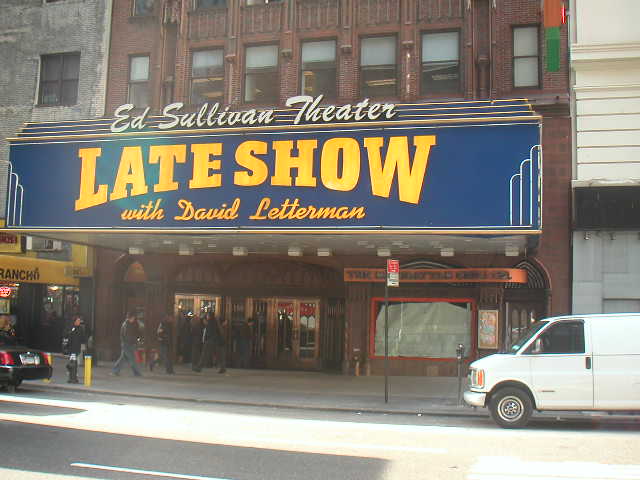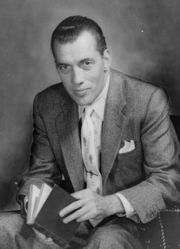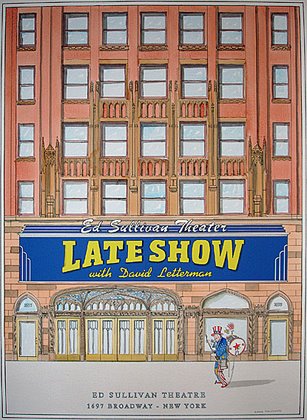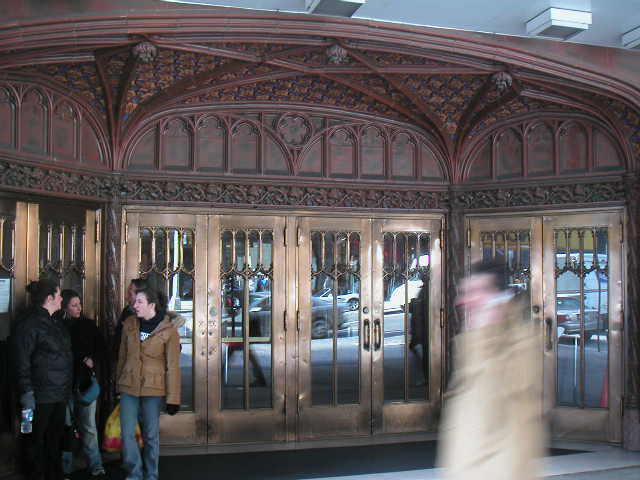|
The Ed Sullivan Theater, which is located at 1697-1699
Broadway between West 53rd and West 54th Streets, in Manhattan[1], is a
venerable radio and television studio in New York City. The 1200-seat
theatre — of which 400 seats are currently used for TV audiences — has
been used as a venue for live and taped CBS broadcasts since 1936.
It is best known as the longtime home of The Ed Sullivan Show, though
since 1993, it has been the home for the Late Show with David Letterman.
It is on the list of National Register of Historic Places.
First 66 years
The facility was designed by architect Herbert J. Krapp[1]. It was built
by Arthur Hammerstein between 1925 and 1927[1], and was named
Hammerstein's Theater after his father, Oscar Hammerstein I. It later
went by the name Manhattan Theater, Billy Rose's Music Hall, and the
Manhattan once again. In the 1930s, it became a popular nightclub; after
CBS obtained a long-term lease on the property, the network began
broadcasting from there in 1936. It had various names during the
network's tenancy, including Radio Theater #3 and the CBS Radio
Playhouse. It was converted for television in 1950, when it became
CBS-TV Studio 50.
The theater was renamed for Sullivan at the beginning of the 1967-68
season, though it is still TV Studio 50 in CBS's numerical list of New
York television facilities, according to both the network and the
actors' monthly Ross Reports. Sullivan, who started hosting his variety
show from the Maxine Elliott Theatre (CBS Studio 51) on 39th Street in
1948, moved to Studio 50 a few years later.
In the 1960s, Studio 50 was one of CBS's busiest stages -- not only for
Sullivan's program but also for The Honeymooners and Merv Griffin
Show[2] as well several quiz shows. What's My Line?, To Tell the Truth
and Password called the studio home after CBS began broadcasting
regularly in color. (They had usually been taped around the corner at
CBS-TV Studio 52, which is now the disco-theatre Studio 54). Line and
Truth remained at Studio 50 even after they moved from CBS to first-run
syndication in the late 1960s and early 70s. The programs eventually
moved to NBC's Radio City Studios at Rockefeller Center.
Probably because both were CBS stages in the 1950s and 60s, Studio 50
once had access to Studio 52 (the current Studio 54 Building) through an
access door which was cinder-blocked during the Ed Sullivan Theater's
Letterman renovation.
The Ed Sullivan Theater was also the first home for The $10,000 Pyramid,
with its huge end-game board at the rear of the set, in 1973. Other
short-lived game shows produced at the Ed included Musical Chairs with
singer Adam Wade (1975), Shoot For The Stars with Geoff Edwards (1977)
(which was an NBC show), and Pass the Buck with Bill Cullen (1978).
The CBS lease on the building expired in 1981[3] and it was used as a
Reeves Entertainment teletape facility, it hosted the sitcom Kate &
Allie.
The Late Show
The Ed Sullivan Theater in 2007.When David Letterman switched networks
from NBC to CBS, CBS bought the theatre in February 1993 for $4 million
from Winthrop Financial Associates of Boston[4]. The theatre was
reconfigured into a more intimate 400-seat studio, with lighting and
sound adjustments. The architectural firm that did the work, Polshek
Partnership, notes on its website that "to preserve the architectural
integrity of the landmark, all interventions are reversible."
In 2005, it took nearly four months to retrofit the theater with the
cabling and equipment necessary to broadcast high definition television.
Near the beginning of the first Letterman show in the fall of 1993, a
quick reference was made to Sullivan's legacy, by splicing together
several short clips of Sullivan introducing various acts, including,
presumably, the singing group called The Lettermen. This resulted in a
fake clip of Sullivan that sounded like "And now, here on our stage...
David... Letterman!" Letterman also joked that his crew opened an old
closet in the theatre which contained a 45-year old woman screaming
"Ringo!"
References
^ a b c White, Norval & Willensky, Elliot; AIA Guide to New York City,
4th Edition; New York Chapter, American Institute of Architects; Crown
Publishers/Random House. 2000. ISBN 0-8129-31069-8; ISBN 0-8129-3107-6.
p.266.
^ A Building With a History, From Bootleggers to Beatles - New York
Times - February 22, 1993
^ A Building With a History, From Bootleggers to Beatles - New York
Times - February 22, 1993
^ CBS Buys a Theater To Keep Letterman On New York's Stage - New York
Times - February 22, 1993
|





.jpg)